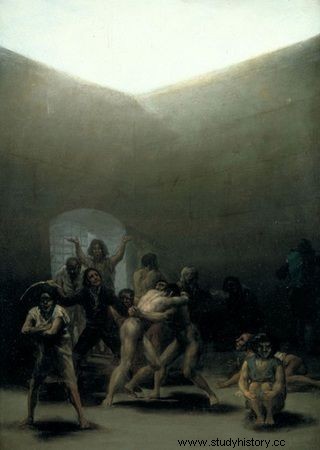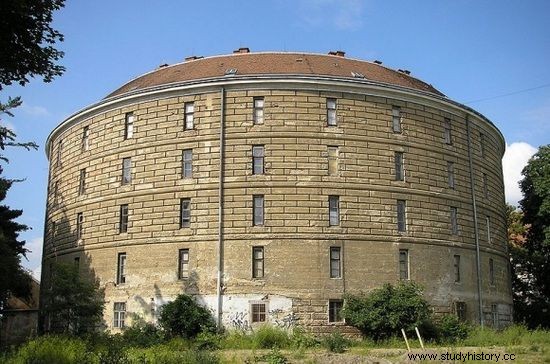They were lashed, stigmatized, their heads shaved and exorcised. Everything is in vain. Eventually, someone came up with the idea that the insane must simply be locked up. And it has remained so until today.
Mental diseases have been afflicting people since the beginning of history. Over the centuries, this has been handled differently, considering the insane as inspired by the gods or as servants of the devil. In the Middle Ages, an unenviable fate was prepared for the sick. These alleged possessions, sorcerers and blasphemers were burned at the stake, basked in the water, and finally imprisoned with criminals (many of them would never see the light of day again). 
Those who escaped such a fate lived in the streets of cities and wandered along the roads, without any care, like animals. Such a situation did not please the sane inhabitants, and the sick were closed so that they would not offend the rest with their presence.
A real "madhouse"!
The Polish historian Jerzy Besala, in his book "Na Zakrętach Historia", cites the information that in 1606 one of the first "plague houses" in Europe was opened in Hamburg, part of which was turned into a "madhouse". This place in Hamburg was more like a prison or barracks surrounded by a moat than a place for recovery. Effective methods of treatment were daily drills, hard work, strict order of the day, and also learning to read, write and ruthlessly inculcate piety .

Afternoon entertainment in a typical modern-era nursing home. As you can see, the patients are having a great time!
However, when we turn to an older publication, namely the work by Leon Wachholz published in 1924, "Krakow Hospitals 1220−1920", we learn that the palm of priority in the field of care for the insane does not belong to Hamburg. It is probably safe to say that Poles were one of the precursors of "care" for the mentally ill.
Between the cemetery and syphilitics
As early as 1534, the townspeople of Kraków founded the first hospital for the mentally ill. This institution quickly fell into oblivion, because a century and a half later the local bishop Andrzej Zawisza Trzebnicki of the Swan coat of arms wrote in his will that the plant was built of wood because it had no income, because of old age and as a result of war disasters, it was so damaged that it was not remembered [ even] the place it was located in .

"Tower of madmen" of Emperor Joseph II (license CCA 2.5 G; photo by Gryffindor).
Fortunately, information about his location has been preserved in the documents of another Krakow bishop, Cardinal Jerzy Radziwiłł. According to these records, the hospital was located behind the New Gate, which does not exist today, between the Chapel of Saint Gertrude and the Hospital of Saints Sebastian and Roch.
It would not be surprising, after all, the spiritual company of the tabernacles dedicated to the patrons bathing in God's glory should have a good influence on the process of healing the mentally ill.
There is only a minor but. To put it mildly this part of Krakow was not considered the best district, the chapel of St. Gertrude was a cemetery chapel for convicts and those who were denied a Christian burial, and the hospital was a shelter for venereal and infected people, i.e. infectious diseases . Well, it speaks volumes about the attitude towards madmen at the time.
It wasn't swan song at all
But let us return for a moment to Bishop Trzebnicki. The head of the Krakow church, observing the situation of the madmen, decided to help them somehow. In order to secure their existence, he intended to create a special facility. It was to be located in the chosen tenement house on Szpitalna Street, displayed a fundamentis, with all the space, order, condition and comfort for pacarells, alias for crazy people .

Bishop Andrzej Zawisza Trzebnicki, thanks to his testament, Krakow has a modern hospital for the mentally ill at its time.
The bishop also secured the financial existence of the tabernacle. He made records that allowed for the maintenance of six "residents". Under the care of the hospital, called the "House under the Swan" (from the coat of arms of the founder), sick clergymen and lay people, coming from the nobility, as well as people of lesser birth, were to be placed. The tabernacle was also to have a surgeon, a medic, medicines, and a steward who would pay.
The "crazy tenement house" was, by the standards of the time, a modern and impressive care facility. Over the years, the sick were treated better and better, and in 1784 even the square around the building was fenced and a garden was set up in it, where the insane could enjoy fresh air. The orders and documents of the Austrians from the eighteenth and nineteenth centuries regarding the admission and release of patients from the facility prove that it was done very humanely. Taking into account the fact that in 1784 Emperor Joseph II built a tower in Vienna, which was a prison for the sick, and eight years later, the French precursor of psychiatry had to guarantee with his life the release of madmen from shackles and shackles, the Krakow hospital was definitely ahead of its time!
